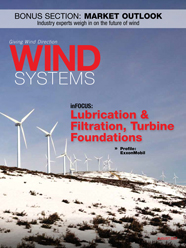When it comes to wind-turbine foundations, it seems appropriate to reflect on the traditional way foundations have been built and how their structural integrity can be improved and, at the same time, save money and enhance safety.
One of the traditional ways foundations are built has been by using foam rings in the grout trough to prevent grout from making contact with the foundation anchor bolts. Should the grout make contact with the rods, it could interfere with tensioning by not allowing the rod to pull through the grout as it is being pulled from above. Theoretically, the foam also would prevent grout from moving into the bolt sleeve, which spans the full depth of the pedestal and allows the rod to move within the foundation as the tower sways back-and-forth, acting like rubber bands alternatively under compression and expansion.
Same Process
Foam rings are still predominantly used today and the process is no more sophisticated than it was at the beginning. First, the bolt sleeves are sealed at the top by placing a bead of caulk around the rod within the bolt sleeve. Then, someone has to cut the foam into rings equivalent in length to the prescribed grout depth. The rings are dropped over the rods in the grout trough and often have to be wrapped with common duct tape to keep them from splitting when the base is set. It’s a throwback from the days of the backyard mechanic. It’s hard to believe a multimillion-dollar machine is being built using caulk, foam pipe insulation, and duct tape.

(Courtesy: NTC Wind Energy)
Right now, a couple of employees are handed sharp knives and told to cut 14,000 two-inch rings (enough for 100 average foundations) by quitting time and then make sure the first aid kit is ready. After a day of cutting foam, those two-inch rings end up being long or short, either of which diminishes their functionality. Then comes the job of caulking and taping — a tedious task at best.
The Early Days
Back in the early days, grout was poured into an open foundation, and the base was set in the grout. It was not uncommon to find the foam rings floating in the grout. Cementitious grout also was used, which, if allowed to contact the rod, would generally break away from the rods as they were pulled through the grout during tensioning. Occasionally, while setting the base on the grout-bed, the grout would push into the base-flange boltholes where it would interfere with the proper seating of the washer and nut during tensioning.
Happily, some things have changed for the better. Now high-strength, flowable epoxy grout is used, and the grout is applied with the base in place using forms. This has proven to be a superior material and method of grouting. But the superior grout also makes it that much more important that the rods be protected from contact with the grout. But, foam is still predominantly used.
The ongoing trend toward heavier and taller turbines means more grout and supporting leveling shims in the grout trough, adding to the potential for voids. Basically, the more hardware in the trough, the greater the potential for voids. Unfortunately, with the base down, it is difficult to detect those voids.
Adding to the Problem
The use of foam rings inadvertently adds to the problem. Each ring of foam creates a void in the grout, further reducing the overall compressive strength of the grout bed. Applying some basic math: a foam ring 2 inches tall and ½-inch thick, having an ID of 1 5/8 inch displaces 6.676 cubic inches of grout. If the grout reaches 14,000 pounds of compressive strength when cured, the loss of compressive strength in a foundation with 140 foundation anchor bolts is more than 13 million pounds or 6,500 tons. A total of 6.58 cubic feet of grout in that foundation has been displaced. Admittedly, the remaining grout is more than enough for structural integrity, and in foundation design, engineers compensate for potential grout voids. But why not eliminate as many voids as possible, increasing the quality and structural strength of the foundation?

Though the industry has an excellent record for foundation integrity, the trend is increasingly toward engineers building in design excesses to ensure their design will not fail. At some point, the cost versus the benefit of these design excesses will have to be examined. If the foam rings in the foundation could be eliminated, perhaps some money could be saved by reducing the size and depth of the grout trough or by reducing the compressive strength requirements of the grout in order to have a better foundation.
IronClad Grout Sleeve
The advent of NTC Wind Energy’s patent pending IronClad Grout Sleeve addresses all of the concerns listed above. These injection-molded parts slide easily over the rods but fit tightly enough to seal around the bottom of the rod and stay in place, negating the need to caulk around the top of the bolt sleeve. At the same time, the thin walls of the polyethylene parts displace little grout. At 3 1/2 inches tall, grout sleeves are intended to project into the flange slightly, protecting the entire exposed portion of the rod and allowing the rod to easily move during tensioning. Like foam rings, grout sleeves allow the rod to move laterally within the bolt sleeve to line them up during base setting.
Grout sleeves are also useful for over-wintering foundations. By placing a ½-inch ring of caulk around each rod and installing the sleeves on top of the wet caulk, the sleeves provide a protective seal against water and mud draining into the bolt sleeve within the foundation.


































